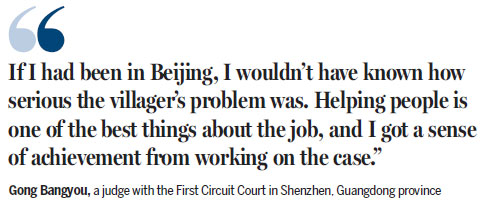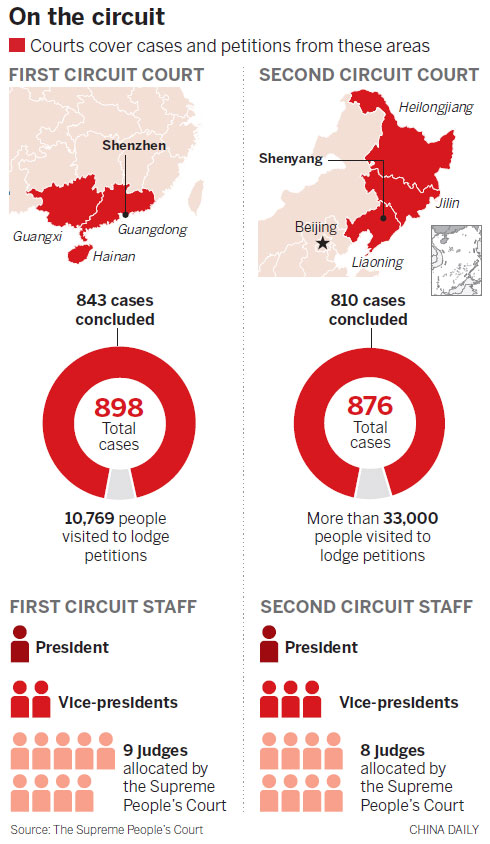Putting the legal ball in a new court
Updated: 2016-02-24 08:04
By Cao Yin(China Daily)
|
|||||||||
Since they were established a little more than a year ago, China's first circuit courts have changed the country's legislative landscape. Cao Yin reports from Shenzhen, Guangdong province.
Looking back at the first year of the First Circuit Court in Shenzhen, Guangdong province, Gao Xiaoli, who has worked as a chief judge at China's top court since 1994, said she has had no time to feel homesick, even though she only returns to Beijing once a month.
The new circuit courts, which act as branches of the Supreme People's Court, the nation's top legal tribunal, are part of a two-year pilot program related to ongoing reform of the judiciary. Before their foundation, all cases referred to the Supreme People's Court had to be heard in Beijing.


|
A man applies to file a case with a clerk at the First Circuit Court of the Supreme People's Court in Shenzhen, Guangdong province, on Feb 2, 2015. Mao Siqian / Xinhua |
Last month, President Xi Jinping said the reforms must be deepened to boost to the country's judicial credibility and the public's sense of security. Meanwhile, experts said the country's top court regards the establishment of circuit courts as one of the first steps in the reform process.
In January last year, the Supreme People's Court established China's first circuit courts. The first is in Shenzhen, a services center in the Pearl River Delta, and rules on disputes in the provinces of Guangdong and Hainan and in the Guangxi Zhuang autonomous region, while the second is in Shenyang, the capital of Liaoning province, and hears cases from Northeast China's traditional industrial provinces - Liaoning, Jilin and Heilongjiang.
Circuit courts not only narrow the physical distance between the top court and litigants, but they also underscore the authorities' determination to reform the judicial system, experts said.
Change of focus
For many years, the country's most-senior judges performed tasks more suited to civil servants. They were given administrative titles, such as chief judge or president, in accordance with seniority, but once that title had been awarded, the focus of their work shifted from hearing cases to managing the court.
Although administrative matters occupied most of their time, many were also reluctant to preside over trials, because it meant accepting a heavier burden of responsibility and a greater workload. As a result, many judges rarely heard cases, rendering their legal and procedural experience almost useless when it came to resolving the ever-rising number of court cases.
Statistics released by the Supreme People's Court show that nearly 13 million cases were resolved in 2013, a rise from the 8.56 million recorded in 2006. However, the number of judges nationwide failed to rise in tandem with the number of cases. In 2013, there were 196,000 judges, just 6,000 more than in 2006.
The Supreme People's Court decided the problem needed to be rectified, and in 2013, the central leadership proposed judicial reform, emphasizing that judges should not be used as administrators and their work should revolve around hearing cases.
Leading judges were ordered to "pick the gavel up again" and to spend more time on legal matters. As a result, the Supreme People's Court transferred 88 legal officials from its head office in Beijing to the two new circuit courts.
Going to the grassroots
From her position as a chief judge, Gao has enjoyed a bird's-eye view of the changes.
At the Supreme People's Court, judges often rule on appeals of verdicts handed down by provincial high people's courts. But most of their work revolves around deciding whether there are legal grounds for retrials of cases that have already been reviewed twice in the lower courts.
Gao said that before the establishment of the circuit courts, she and her peers often worked on verdicts or retrial decisions in their offices in Beijing. They based their judgments on materials and case documents submitted by the lower courts. The result was that they had little or no contact with the litigants themselves, so they knew almost nothing about their personal circumstances.
Now, through her work with the First Circuit Court, Gao visits litigants in their homes, workplaces or other locations and conducts face-to-face talks to resolve conflicts or petitions in person.
"Last year, I went to Hechi and Baise in the Guangxi Zhuang autonomous region to resolve disputes at litigants' homes," she said. "In the past, most judgments I made were based on materials provided by lower courts, so I never actually met the people involved."
In Hechi, which is rich in nonferrous metals, she helped resolve a contractual dispute between two partners in a mining company. "If I hadn't gone there, I would never have really understood the nature of the dispute, because I had no idea about the technical terms and how local enterprises operate. However, when I visited the city and spoke with the people involved, I quickly understood the situation," she said.
Last year, Gao's colleague, Gong Bangyou, traveled to Wuzhi Mountain, Hainan province, and resolved a 20-year-long dispute over home ownership. The local court had pronounced a verdict many years before, but the plaintiff claimed the decision was flawed. His repeated pleas fell on deaf ears, so when the First Circuit Court was established he lost no time in making contact.
"I received a petition from a villager in Hainan, who pointed out mistakes in the original verdict. My visit allowed me to confirm that he was right," Gong said. "The local lower court had refused to retry the case and repeatedly ignored the petitioner, which was why the dispute lasted so long. I was shocked by the man's shabby home in the mountains, and realized that the case needed to be concluded as quickly as possible. I arranged a meeting with the 15 people involved in the dispute, and after four hours of mediation we came to a solution.
"If I had been in Beijing, I wouldn't have known how serious the villager's problem was. Helping people is one of the best things about the job, and I got a sense of achievement from working on the case," he said.
Qi Su, a judge at the Second Circuit Court in Shenyang, said the court improved efficiency by arranging hearings at the homes of 195 litigants last year, and also ruled on a large number of petitions.
Official statistics show that last year the two circuit courts dealt with 1,774 cases, and ruled on more than 40,000 petitions that would have previously been submitted to the Supreme People's Court in Beijing. The court in Shenzhen dealt with 10,769 petitioners, while its counterpart in Shenyang handled more than 33,000.
"The court gates were flooded by more than 1,000 petitioners on our first day in operation, but the number had fallen to about 100 per day by December," Qi said, adding that the courts help petitioners avoid the need to travel to Beijing repeatedly to lodge appeals.
Greater convenience
According to Yu Zhengping, vice-president of the Second Circuit Court, the pilot program aims to reduce official interference in hearings, and the verdicts delivered by the judges are used as guidelines by grassroots courts. Moreover, using the circuit courts saves time and money.
Huang Sizhou, a lawyer in Shenzhen, was relieved that he doesn't have to travel to Beijing with clients who have lodged appeals.
"I am no longer worried about failing to book a hotel near the top court, and relieved that I don't have to squeeze on the crowded subway during the capital's rush hours," he said.
He added that he has received many calls from litigants looking to lodge appeals with the First Circuit Court, including some residents from Jiangxi province, which was originally under the jurisdiction of the Supreme People Court in the capital.
"The distance from Jiangxi to Shenzhen is less than 1,000 kilometers, far shorter than to Beijing, so it makes sense," he said.
Zhao Xudong, a professor of law at the China University of Political Science and Law in Beijing, said the pilot program is implementing the rule of law the leadership highlighted in 2014, and the move has reassured many people that their cases will be heard fairly and justly.
Wang Weiguo, Zhao's colleague in the university's law department, also gave the reform the thumbs-up, saying the circuit courts have bolstered judicial credibility. He recommended the establishment of more circuit courts nationwide, but acknowledged that it will be hard to persuade many judges to work outside Beijing, and training more senior judges will not be an easy task.
"It's just been the first year. Many judges were excited to experience a new way of handling disputes, but inevitably it will be difficult for them to maintain their enthusiasm for hearing cases at litigants' homes once it becomes commonplace," he said.
"Also, training and cultivating senior judges is a time-consuming job, so great attention must be paid to ensuring that the judges dispatched to circuit courts are as highly qualified as possible," he said, adding that encouraging top judges to join the pilot program is a challenge the top court will have to overcome if the reforms are to be successful.
Contact the writer at caoyin@chinadaily.com.cn
Building bridges
The First Circuit Court in Shenzhen, the site of China's first Special Economic Zone and a pioneer of reform in Guangdong province, has contributed to improved judicial communication and cooperation between the Chinese mainland, Hong Kong, Macao and Taiwan, according to an official at the Supreme People's Court.
The establishment of the court in Shenzhen was partly motivated by the need to deal with the rapidly rising number of cases and also with new types of disputes - such as those involving new technologies for which few laws have yet been formulated - in Guangdong and the neighboring regions. In addition, the new court has made it more convenient for residents of Hong Kong, Macao and Taiwan to lodge lawsuits in the mainland, Liu Guixiang, the circuit court's president, said.
"Since it was established last year, the circuit court has played a major role in handling cases involving Hong Kong, Macao and Taiwan, and has also helped to implement verdicts in line with legal aid contracts," Liu said.
Last year alone, cases related to Hong Kong, Macao and Taiwan accounted for 30 percent of the hearings held at the court, which also issued guidelines covering the delivery of legal materials and the collection of evidence between Taiwan and the mainland, he said.
Gao Xiaoli, a judge who specializes in civil and commercial cases outside the mainland, said the new branch of the Supreme People's Court is a "window" that allows Hong Kong to understand the work of the mainland judiciary.
Statistics released by the top court show that last year the Shenzhen circuit court was visited by more than 70 legal professionals from Hong Kong, Macao and Taiwan, who observed proceedings to gain greater insight into the mainland's judicial reforms and legal procedures. Seven judges from the circuit court also traveled to Hong Kong to further explain matters.
"This legal interaction has become more frequent since the circuit court was set up last year. The top court has encouraged us to improve communications with legal professionals in the three areas to alleviate misunderstandings resulting from the use of different judicial systems," she said.
"The rising number of economic exchanges with these areas means greater judicial understanding is crucial. We need each other and will make great efforts to learn more about each other's working practices and systems," she added.

(China Daily 02/24/2016 page6)
Today's Top News
Tech giants reveal 5G innovations in Barcelona
Mechanism to be built to monitor ceasefire in Syria
London mayor says to support Brexit in EU referendum
What ends Jeb Bush's White House hopes
UK to hold EU referendum on June 23
US saber-rattling could spark arms buildup: experts
Balkan, Austria police agree to register refugees
Turkey blames Kurds, Syria for attack
Hot Topics
Lunar probe , China growth forecasts, Emission rules get tougher, China seen through 'colored lens', International board,
Editor's Picks

|

|

|

|

|

|







